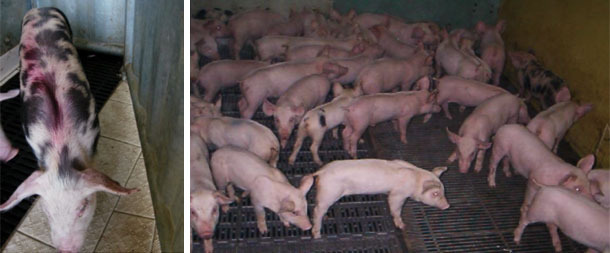Introduction
We were called in October 2011 because of an important drop in growth performances and mortality of piglets around 25-38 days of age.

Health problems are common at this stage (colibacillosis, arthritis), but it was the first time the farmer saw such severe clinical signs appearing so quickly.
Farm description and context
This 880-sow farrow-to-wean farm is located in a high pig density area, in Brittany (France). Piglets leave the farm at 10 weeks of age and are fattened on 3 other sites.
This commercial herd was populated 2 years ago, with replacement gilts coming from a farm with a very high health status.
All females are bred by artificial insemination using semen obtained on the farm. The batch management consists of 20 batches with farrowings every week. Piglets are weaned at an average of 21 days of age.
The farm is managed by a manager and 3 employees. The 4 of them are extremely rigorous concerning internal and external biosecurity.
Health status known in October 2011:
- PRRSV: negative since the repopulation of the farm
- Actinobacillus pleuropneumoniae (serotypes 2 and 1-9-11): negative
- Aujeszky’s disease: negative
- Mycoplasma hyopneumoniae: negative since the repopulation
- Haemophilus parasuis: positive on both gilts and piglets
Prophylaxes:
- Porcine parvovirus (gilts and sows)
- Erysipelas (gilts and sows)
- Clostridial and coli infections (gilts and sows)
- PCV2 (gilts and sows)
- Ivermectin (gilts and sows)

Situation in October 2011
Visit of the farm
♦ Quarantine: The quarantine premises are isolated from the rest of the farm and managed with an AIAO system. The replacement gilts come from the same nucleus farm since the repopulation of the herd. There is a history of Glasser’s disease on gilts after their delivery, but the problem seems to be under control since several months ago.
No clinical problem was seen during the visit or was mentioned by the manager.
♦ Gestation rooms: The fertility rate is quite good: 91% during the last 6 months. No clinical problem was seen during the visit or was mentioned by the farmer.
♦ Farrowing quarters: The results of the last 5 months before the visit are shown in the table in comparison with the reference results of French pig herds.
| The farm 01/06/2011 - 14/10/2011 | 33 % best French herds 2010 | 10 % best French herds | |
| Weaned/sow/year | 31.2 | 30.4 | 31.6 |
| Total born/sow | 14.52 | 14.5 | 14.7 |
| Born alive/sow | 13.56 | 13.5 | 13.8 |
| Stillborn/sow | 0.96 | 0.9 | 0.9 |
| Weaned/litter | 12.19 | 12 | 12.3 |
| % of stillbirths | 6.6 % | 6.4 % | 6.1 % |
| % of losses in suckling piglets | 10.1 % | 11.6 % | 10.6 % |
No clinical problem was seen during the visit or was mentioned by the farmer neither regarding the suckling piglets nor lactating sows.
♦ Post-weaning (Nursery) unit:
During the first year after the repopulation, we had to deal with arthritis due to Haemophilus parasuis among weaned piglets. At the time of the visit, this problem was under control with an in-water amoxicillin treatment (20 mg/kg bw/day during 5 days after weaning).
Since the last 3 months, we have to manage E. Coli problems, most of the time between 23-27 days and 40-45 days of age. Two treatment periods are carried out with colistin (3.3 mg/kg bw/day during 5 days) at these age periods.
In order to reduce antimicrobial use, the farmer told us he was trying a draining litter on the soils and in the feeders from weaning to 50 days of age. This litter contains zinc oxide but we could not obtain the exact composition on the day of the visit.
In the last 4 batches of weaned piglets, the farmer saw around 3% of anorexic and lethargic piglets. All the treatments he tried failed (amoxicillin or florfenicol injections), and finally the piglets died

Anorexic and lethargic piglets seen during the visit
Differential diagnosis
| Hypotheses | In favour | Against |
| PCV2 (PMWS) | Wasting syndrome Mortality Physiological stage |
Very good zootechnical management (colostrum management, minimal mixing in suckling piglets and after weaning) |
| PRRSv | Wasting syndrome Mortality |
No respiratory signs No reproductive signs on the sows |
| E coli | Recent history on the farm Wasting syndrome |
No diarrhoea of dehydration seen in the affected piglets |
| Glasser’s disease | History on the farm Wasting syndrome |
No respiratory signs No arthritis |
| Porcine periweaning failure-to-thrive syndrome (PFTS) | Wasting syndrome Mortality Physiological stage |
Rare Not described in Europe at the time of the visit |
Laboratory investigation
Some analyses had been performed in November 2011, a few days after the beginning of the outbreak:
- A PRRSv serological survey was performed on several batches of weaned piglets: 10 piglets of 4, 6, 8 and 10 weeks of age, respectively. All the samples were seronegative.
- Two affected piglets were sacrificed on the farm the day of the taking of the blood samples for PRRS diagnosis. No E coli nor Haemophilus parasuis infection lesions were seen.
- In addition, two other hairy piglets with anorexia, weakness, and cachexia were sent to the local laboratory, sacrificed and necropsied in order to determine the causative agent of the disease (with a special focus on PMWS and PFTS):
- Macroscopic lesions:
- Atrophied thymus
- Digestive tract: empty
- Faded liver
- Faded kidneys
- Microscopic lesions:
- Nasal turbinates: Multifocal lymphoplasmacytic infiltration of the mucosa
- Thymus: atrophy but no associated specific lesions
- Stomach: Multifocal lymphocytic infiltration of the mucosa
- Intestines: numerous bacterial clusters; villus of the small intestine are atrophied
- Macroscopic lesions:
|
Current knowledge on the porcine periweaning failure to thrive syndrome (PFTS)
Clinical signs
Little is known about PFTS. Publications are recent.
|
The most frequently observed clinical signs and pathological changes are listed in table 3.
Table 3: most frequently observed clinical signs and pathological changes in case of PFTS
| Clinical signs | Pathological changes |
| Anorexia | Chronic active rhinitis |
| Lethargy | Lymphocytic superficial fundic gastritis |
| Standing but unwilling to move | Atrophic enteritis |
| Sneezing | Superficial colitis |
| Repetitive oral behavior | Thymic atrophy |
The clinical signs and pathological changes observed in our case are highlighted in red.
Aetiology
The aetiology of PFTS is presently unknown. Suspicions include infectious agents, non-infectious factors, or both [Huang et al., 2011].
In our case, the massive use at weaning of the draining litter was highly suspected, because it was concomitant with the outbreak of the clinical observations.
We decided to take a sample of the product and sent it to a chemical lab able to test some elements like arsenic and lead because I heard about this type of contamination with some zinc oxide sources. The results of the analysis are presented in the figure 1.
Figure 1: Analysis report of a sample of the draining litter (heavy metals / trace elements)
| Cadmium | mg/kg | < 0.50 |
| Mercury | mg/kg | < 0.02 |
| Lead | mg/kg | 6.78 |
| Arsenic | mg/kg | 7.71 |
Explanation “<”: undetected, underneath the quantification limit
Actions proposed and evolution
The farmer used this litter in high quantities to dry the floors but also to prevent colibacillosis, because of the high level of zinc oxide present in the product.
As this product was suspected of being the etiologic agent, he was told to stop using it and to replace it by another food supplement containing minerals, vitamins, and zinc oxide (from an in-food quality sourcing).
Two weeks after the complete stopping of the use of the litter at weaning, no more signs of PFTS were seen on the critical-aged piglets.
Discussion
PFTS must be part of the differential diagnosis when one is facing anorexia, cachexia, weakness, and mortality of weaned piglets.
The diagnosis could be easily made thanks to the combination of the clinical signs and the histology of several organs (especially thymus, digestive tract, nasal turbinates) but the laboratory was warned about the clinical suspicion in order to test the appropriate samples.
The most difficult part is to identify the aetiology. Infectious diseases could be responsible for this syndrome, though it was probably not the case here.
In our case, the use of a non-edible product as a food supplement was highly suspected, because of the high rates of lead and arsenic in its composition, but also because of the several contact routes for the piglets: oral, nasal, and skin.
It is not possible to say if the product is responsible for the clinical observations either because of its taste (sufficiently disgusting to definitively lead to anorexia some piglets) or because of intoxication of young piglets (regarding the fact that it is impossible to measure the quantity eaten by the sick piglets).
Unfortunately, the confirmation of this hypothesis was not possible because we did not send to a specialized toxicology lab the livers and kidneys of the 2 sacrificed piglets.
As the elimination of the product did improve the clinical situation, the manager did not wish to invest in other lab tests, but it is all the more likely as such a clinical episode did not happen ever since the elimination of the product.
This clinical picture of PFTS in a French PRRSv-free farm completes the recent and first observation of PFTS in Europe [Segalés et al. 2012]. This paper underlined the difficulties for excluding PRRSv as a causative or related agent in the condition, due to the high prevalence of PRRS in Spain. Our observation confirms that the syndrome is not necessarily related to this viral infection.





